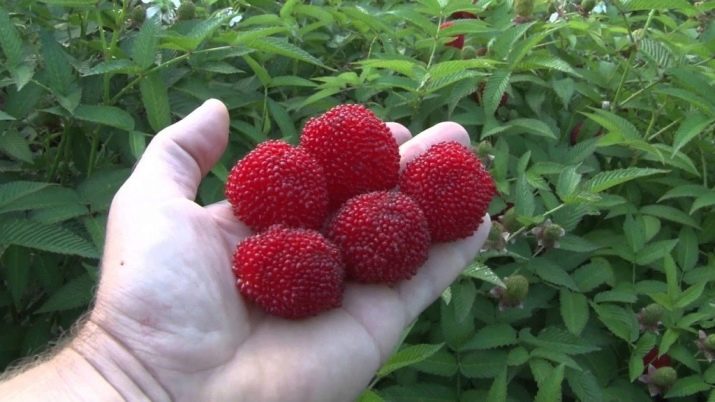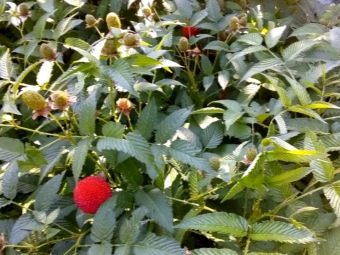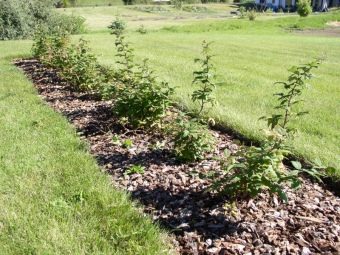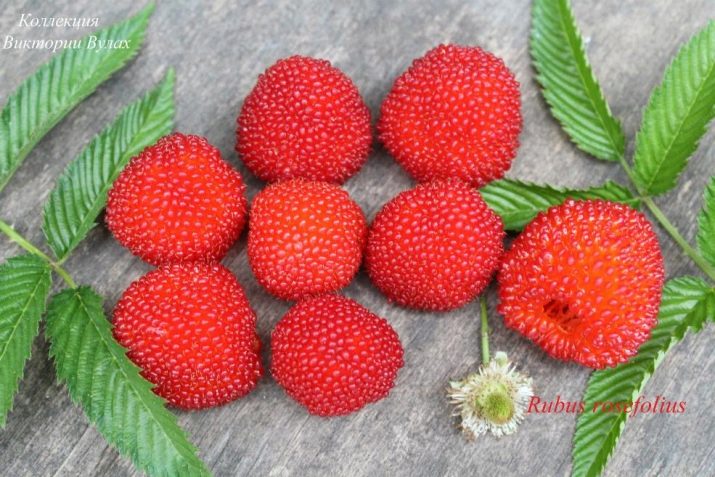Features of growing Tibetan or Rosolist raspberry
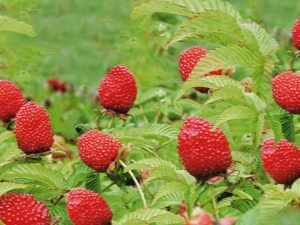
The unusual Tibetan raspberry berry is found infrequently in areas of Russian summer residents.But, for example, in the Baltic countries, it is very common. In this case, the fruits are used not only for human consumption, but also for decorating gardens due to the beauty and decorative properties of the shrub. Externally, the berry is something between raspberries, blackberries and strawberries, and to taste in the fruit there are strawberry notes.
Variety description
The scientific name of this culture is seductive raspberry (Rubus Illecebrosus). In different countries, it is known as strawberry, rozolistnoy or Tibetan raspberries. The origin of this shrub is the territory of Japan, North China and the Himalayas. The culture is a spherical shrub from 30 to 70 cm. It has an unusual rippled foliage of light green color and large berries of coral color, reaching 3-5 cm in diameter. This raspberry variety usually blooms in June with white flowers, and the fruits are formed in late autumn.
Interesting fact: the fruits of the Tibetan raspberry, unlike the usual raspberry, are not hidden under the foliage, but directed upwards, therefore it is much easier to collect them. Ripe sweet-sour fruits are easily separated from the receptacle. In Western countries, “Tibetan” raspberries are called strawberries and raspberries, as they are a hybrid of two berries, although this is scientifically impossible.
Benefits and harm of berries
Like many garden berries, rosemary raspberry is good for health, as it contains many vitamins and nutrients, such as:
- vitamin C serves as prevention of colds, supports immunity at the proper level;
- vitamin p is a prevention of cardiovascular diseases and is an inhibitor of the aging process;
- vitamin A positive effect on the skin and regulates protein synthesis;
- iron maintains hemoglobin in the blood at the proper level;
- copper strengthens hair and maintains optimal hormonal status;
- potassium responsible for the proper and regular supply of cells with nutrients;
- high content pectin It has a positive effect on the digestive tract and stimulates intestinal motility.
Contraindicated use of rosewood raspberry only diabetics and allergies.
Of course, like any other plant, the Tibetan raspberry has its drawbacks. The main disadvantage is that the fruits are not as tasty as regular raspberries. That is why many gardeners use the decorative properties of this crop, planting it as a framing of the site along the barriers or combining shrubs with other elements of landscape design.
Another unpleasant moment is that the shrub is covered with sharp thorns, which are located so close to the berries that it is a problem when they are harvested, so you should take care of the gloves. Yes, and jagged leaves cling to clothes like plaster. Only as a barrier such thorns and sheets will become a virtue.
An interesting fact: since Tibetan raspberry is a rather sour berry, it can be added to salads and other vegetable dishes, where there are tomatoes, peppers or onions.
Breeding methods
Raspberry raspberries can be propagated by grafting, processes or seeds. Experts advise to engage in breeding culture in the autumn after harvest. To produce grafting, the bush is dug out and divided into parts, with each one having a bud. Seedlings are placed in a spacious hole, so that the roots are not crowded in the future. Adult stalks are cut off and as a result there remains a “stump” up to 3 cm high.
Reproduction by shoots can be done using shrubs that are more than 5 years old, because there are usually many young shoots around such specimens. With the help of a sharp shovel, the shoots are dug up and then placed in a spacious landing pit. This procedure can be carried out both in late autumn and in early spring. The main thing is that the shrub was not in the phase of active growth.
Seed propagation is a rather complicated process, so gardeners do not use it so often. To get the seeds, the overripe berries are crushed and left for 2-3 days in the form of a slurry. After it is washed with a sieve, and the extracted seeds are dried. Sand is poured into the food container, and the dry seed is deepened there by 2–3 mm. The container must be refrigerated for a month and then returned to room temperature.
Provided regular watering and proper care of the seedlings in 3-4 weeks should appear the first shoots.
Planting and care
When choosing seedlings, it is necessary to purchase copies without damage, yellowed or twisted sheets, so that it does not happen that the shrub will die in a few days. Tibetan raspberry is a fairly unpretentious plant, so it can be planted both in the sun and in partial shade, although it is the lighted places that suit it more. Rosy-colored raspberry doesn’t like only humid and low-lying places, where rainfall constantly accumulates throughout the year.
Shrubs need to be planted at the end of September or at the beginning of October, in this case the viability of the plant will be high, and the seedling will surely take root. For planting suitable neutral or alkaline fertile land.
Before planting, a bucket of peat and a half-bucket of manure humus should be placed in each pit about 50 cm deep. And after planting a bush, fill the hole with soil and water it abundantly. The distance between seedlings should be about one meter, since the plant has a developed root system. In case of too frequent planting the bushes will interfere with each other and fertility will decrease. For the same reason, do not plant this crop too close to other garden plants.
The rhizome from the third year of life begins to spread randomly and gives abundant growth. Therefore, it is possible to put an additional barrier around the meter perimeter around the Tibetan raspberry planting perimeter so that the roots cannot harm other crops.
As for the care, this raspberry variety is quite unpretentious and will require a minimum of temporary and financial investments. Watering the bush will have every day, of course, in the absence of natural precipitation, because this culture does not like drying out. At the same time on each bush will need about a bucket of water (10 liters). And in a particularly dry time, the frequency of watering can be increased, in addition, carrying out rain watering or spraying the leaves with water so that they do not dry out. Tibetan raspberries are fed twice a year: in spring and autumn. In the first case, after the snow has melted, the base of the bush is sprinkled with ammonium sulfate granules. And before frosts use potassium sulphide in a dry form.
After the feeding procedure, the root zone is covered with mulch from peat, humus or manure so that as much nutrients as possible penetrate into the root system of the plant. And in order for the culture to survive the long frosts, the bush is cut off in late autumn after the leaves die off. It is enough to leave only 5 cm long twigs. The bush is covered with spruce branches and covered with soil. Since the root system of this raspberry variety is located close to the surface and is quite gentle in itself, you should be very careful when loosening and removing weeds.
Do not use for this garden tools, and do everything manually in special gloves.
Experienced Gardeners Tips
Experienced gardeners, in their reviews of this shrub, note that it is important not only to grow the plant properly, but also to preserve it for the winter. Fresh fruits are stored in the refrigerator for only 2–3 days, and with proper freezing, you can increase the shelf life to a year. Even longer can be stored harvested berries in dried form. From dry raspberries, you can make a healing tea, which is used for colds and vitamin deficiency.
Thrifty housewives have long found Tibetan raspberry use in the kitchen.Sour fruits, mashed with sugar, are not only tasty, but also have a delicate strawberry-pineapple flavor. That is why from the Tibetan raspberry can be produced and fragrant homemade wine. Also, this berry is added to vegetable and fruit salads and used to make pies, desserts and compotes. Tibetan raspberries can be combined in blanks with other berries and fruits, if you want them to get a rich shade or get a delicate aroma.
Tibetan raspberries can be actively used for decorative purposes: in hedges, decorative compositions, in the design of stone hills. The bush is easy to form, it retains fresh greens for a long time, it blossoms and bears fruit at the same time. Bright red berries and snow-white flowers look very picturesque on a lush green background. The ability of a shrub to grow quickly can be used in landscape design.
The plant is planted as a hedge, if you need to strengthen the slopes or hide something unsightly on the site with the help of picturesque thickets of rosemary raspberries.
A berry with prickly stems and leaves can act as a barrier from penetration of animals or unauthorized persons to a site.
Tibetan raspberry is a plant that is unpretentious to care, but if the bush is still attacked by pests, then DDT, copper sulphate, Karbofos, Detoil solution or Bordeaux liquid will be effective to combat them. As well as an effective and safe method will be to remove the infected parts that need to be burned and in no case be used for compost so that the pests do not multiply.
Tibetan raspberry bushes are unpretentious in their care, they successfully take root, multiply rapidly and bring a bountiful harvest of fruits rich in vitamins and other valuable elements. In addition, it is a beautiful ornamental shrub that will decorate any area. That is why planting even a few Tibetan raspberry bushes will satisfy any family needs without large financial investments and time-consuming.
You will learn more about Tibetan or Rosy raspberries from the following video.


